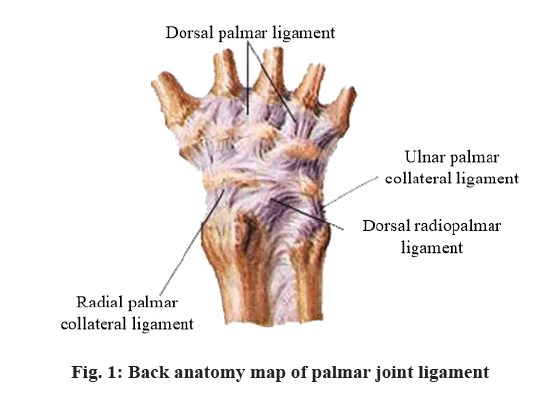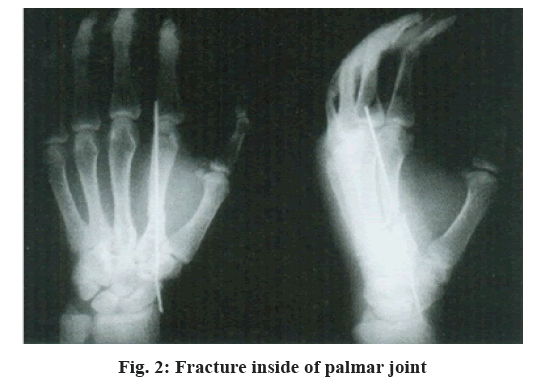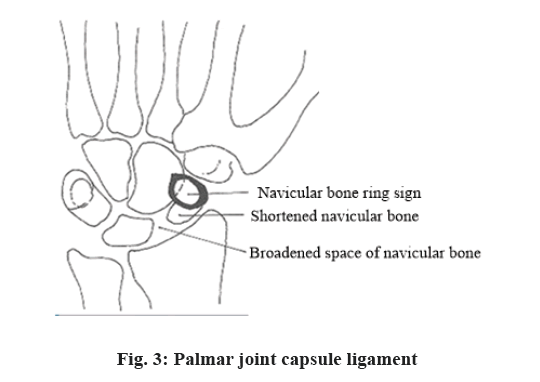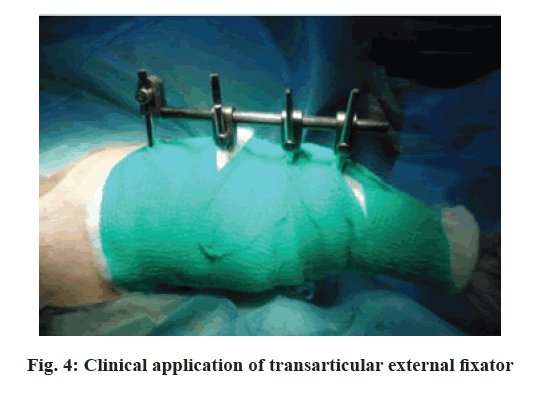- *Corresponding Author:
- Y. Li
Basic Teaching Department, Nanjing University Jinling College, Nanjing 210089, China
E-mail: nanjing18502535982@163.com
| This article was originally published in a special issue, “Clinical Research in Pharmaceutical and Biomedical Sciences” |
| Indian J Pharm Sci 2021:83(1)spl issue “203-206”. |
This is an open access article distributed under the terms of the Creative Commons Attribution-NonCommercial-ShareAlike 3.0 License, which allows others to remix, tweak, and build upon the work non-commercially, as long as the author is credited and the new creations are licensed under the identical terms
Abstract
This study is to explore the influence of palmar lateral joint capsule ligament complex on dorsal stretching stability of wrist lateral joint and to analyze its biomechanical principle, so as to provide reference for clinical medicine. To study the biomechanical characteristics of palmar lateral joint capsule posterior ligament complex, in this study we selected 8 freshly donated body upper limbs including 5 left ones and 3 right ones as research objects. By cutting off forearms and hand soft tissues and leaving wrist lateral joint capsule ligaments, the complex model was made, which can be used as normal sample. Extending from styloid process of radius to styloid process of ulna, we operated on distal ulna and cut off palmar lateral joint capsule ligament complex along an arc line and regarded it as a damaged sample. Through simulating actual clinical operation, the sample was repaired using an external fixation and analyzed according to wrist joint displacement load values. Results showed that regarding the same sample, the comparison of different displacement points was of statistical significance. In all, palmar wrist lateral joint capsule ligament complex is of vital importance, which is a key structure that determines the stability of wrist joint. Once the complex is injured, it will cause extremely serious consequences in which the most significant one is the wrist joint instability. In clinical practice, it cannot achieve very satisfactory effect by only repairing palmar lateral joint capsule ligament complex. By only relying on a transarticular external fixator, the complex can be successfully repaired and thus the complex injury displacement can be avoided and wrist joint stability be secured.
Keywords
Track and field athlete, palmar lateral joint, capsule ligament complex, biomechanics
According to clinical medical analysis, the instabilities of wrist bone and distal radius will cause extremely severe consequences, in which the most common one is fracture dislocation with palmar lateral joint capsule ligament complex injury and thus the instability of wrist joint will be resulted. In clinical practice, there are many researches on biomechanics of wrist joint single ligament. However, there are few researches on the biomechanics of wrist joint capsule ligament complex using external fixation. The stability of palmar lateral joint capsule ligament complex (fig. 1) is very critical, especially for track and field athlete. It not only affects their daily lives and training, but also determines the stability of palmar lateral joint. It is of certain clinical research value to analyze the biomechanics of stability of palmar lateral joint capsule ligament complex, because it can consolidate the stability of players wrist joint[1-7]. In this paper, we explored the correlation between wrist joint displacements and load under 5 modes such as normal, injured, repaired, external fixed and injured external fixed modes. We further studied the influence of palmar lateral joint capsule ligament complex to the stability of dorsal extension and stressed on the exploration of protective effect of external fixation, in the hope of obtaining a highly applicable clinical research finding. Experiment operations are as below. In this study, research samples are fresh body upper limbs, which was donated voluntarily. Of all the donators, there are 6 male donators and 2 female donators, with age between 23-44 y, reaching mean age at (24.5±4.5) y, there are 5 left side limbs and 3 right side limbs. All samples are free from osteoarticular disease. 2 Kuntscher pins, each of which is 3 mm in diameter, were used to process the samples. The Kuntscher pin was horizontally penetrated into radius and ulna and into the 2-5th meta palmar bone and then the sample was fixed in metal slotting clamp under normal pressure and temperature[8-10]. Sample models were prepared by the order of normal, injured, repaired, injured with external fixed. After that the biomechanics of these models were tested. By retaining radius and ulna, interosseous membrane, palmar joint capsule ligament, carpus and metapalmar bone of the sample, it can make the model of joint capsule ligament complex. After testing, the sample was processed, so that different sample models can be prepared including injured sample model, repaired sample model, externally fixed model. After testing their biomechanics, we removed the suture and tested injured fixed sample using external fixation. In this experiment, the mechanical test was conducted using Instron 8874 biomechanical testing system for applying uniaxial compression test. In the beginning of sample test, the position was set as neutral position, while the load point position was set closer to the backside of palmar joint, which is located at lister node ulnar side, the load direction is normally vertical. A 10 kN sensor was equipped at loading rate of 10 mm/ min, when the displacement reached 2.5 cm, loading was stopped and the load change of instrument dynamic phase value was observed. Based on this load change situation, we then drew out a curve and conducted analyses by selecting load value of 1.5, 2.0, 2.5, respectively[11,12]. In this research, a brand new statistical software package SPSS 19.0 was used for data analysis and processing. The enumeration data was expressed by (n, %) and tested by chi square; while the measurement data was expressed by mean value±standard deviation (SD) and tested by t, where in p<0.05 and there was statistical significance. According to biomechanical test analysis, it can be seen that when palmar joint displacement reached 1.5 cm, the load bearing volume of injured sample and repaired sample were relatively smaller, without statistical significance (p>0.05). Other samples were subjected to pairwise comparison and the difference within was of statistical significance (p<0.05). When palmar joint displacement reached 2.0 cm and 2.5 cm, respectively, the situations were consistent with above results. In addition, regarding the same sample, the bearing load value varied a lot as the displacement changed, which met p<0.05, with statistical significance. Taking injured sample as example, when the displacement was at 1.5 cm, the load value was 35.22±13.87; while the displacement was at 2.0 cm, the load value was 87.16±24.21. Through comparing them, T value was 5.2652, p value was 0.0001 and the difference within was of statistical significance. According to medical analysis, palmar joint is a relatively complex system. Its palmar lateral joint capsule ligament has two structures, radiopalmar ligament complex and ulnopalmar ligament complex, which are existed for guaranteeing the stability of palmar joint palmaris. As for carpal joint capsule, it is a thin and loose tissue, which is mainly attached to palmar side of palmar joint. As there is no clear boundary between volar palmar ligament and joint capsule, the complex structure is naturally formed. In the operation process, it should pay attention to following factors of palmar lateral joint capsule ligament before preparing samples. The ligament should be thick and short and the tendinous sheath of extensor at dorsal position should be gradually increasing, which is consistent with that in previous researches. Palmar ligament showed extremely significant tensile strength, which bore large tensile load and transmitted it to distal radius, reaching palmar cortisol and leading to fracture at high tension side. Under the effect of dual pressures such as shear stress and compressive stress, it will cause intra articular fracture (fig. 2), joint capsule ligament injury and thus lead to instability of dorsal stretching of carpal joint. In this study the biomechanics of stability of palmar lateral joint capsule ligament complex was analyzed based on selected samples. Using experimental equipment, we conducted the test of load value upon displacement. Results showed that when displacement reached 1.5 cm, the load value difference between repaired sample and injured sample was of no statistical significance, where in p>0.05; other samples were subjected to pairwise comparison, where in the difference was significant and of statistical significance, p<0.05; when displacement reached 2.0 cm and 2.5 cm, respectively, the results were in consistent with above results. In addition, the comparison of the same sample at different displacements is of statistical significance. In recent years, with the accelerated development of modern medicine, the carpal joint ligament injury (fig. 3) has attracted enough attention. The most direct consequence of ligament injury is carpal joint instability. Track and field athletes are likely to suffer palmar lateral ligament injury during daily trainings and competitions, which greatly impacts their future lives and competitions. Therefore, it must attach great importance to it and take effective treatment method. Currently, anatomic and histological researches on this issue have been conducted. Also, indepth biomechanical discussions have been conducted; however, the results that have been achieved are of certain defects. This paper integrated the researches in these two aspects into a whole and conducted biomechanical researches on palmar radiocarpal ligament complex and palmar ulnar wrist. Carpal joint dorsal stretch injury can cause extremely serious consequences, one of which is directly causing palmar lateral joint capsule ligament (fig. 3) forced to stretch. If the stretching limit exceeds predicted value, it will lead to fiber fracture, which makes palmar joint space gradually increase, so that its stability will be impacted. The research results showed that it can hardly reach long term stability by taking a single repairing measure, the stability was still weak by this measure. Therefore, it is needed to adopt external fixation form such as external fixation as auxiliary equipment, which is a more proper solution from the aspect of clinical analysis. According to previous data analysis, transarticular external fixator (fig. 4) has a wide application range. It is a dynamical type fixation, which is very helpful for fracture reduction and can accelerate the activity of carpal joint in early stage. Therefore, its application range in clinical practice has been increasingly broadened. It is a very helpful measure, which can help fractured patient in reposition and fixation. The future clinical research on the biomechanics of stability of palmar joint capsule ligament complex can start from this point. In all, track and field athletes are very likely to suffer palmar joint capsule ligament injury during their daily trainings and competitions. If timely treatment cannot be guaranteed, it will impact future recovery of joint function. Therefore, we should pay enough attention to the palmar joint capsule ligament injury in clinical practice and take corresponding treatment methods. In this paper, we analyzed the biomechanics of the complex stability and demonstrated related cases where transarticular external fixator was used to improve the clinical therapeutic effect, so as to improve the clinical practicability of treatment method, improve the treatment scheme for palmar joint capsule ligament injury and provide references for clinical medicine.
Conflicts of Interest:
The authors declared no conflict of interest.
References
- Wang R, Huang F, Cen S, Xiang Z. Biomechanical evaluation of stability of the volar capsular ligament complex. Chin J Reparative Reconstr Surg 2008;22(6):684-7.
- Cobden A, Camurcu IY, Cobden SB, Sofu H, Ucpunar H, Sevencan A, et al. Audiometric threshold shifts after total knee arthroplasty by using gentamicin-loaded bone cement. Turk J Med Sci 2019;49(2):514-8.
- Ekin EE, Altunrende ME. The association of reduced bone density with paraspinal muscle atrophy and adipose tissue in geriatric patients: a cross-sectional CT study. Turk J Med Sci 2019;49(2):538-42.
- Roos KG, Kerr ZY, Mauntel TC, Djoko A, Dompier TP, Wikstrom EA. The epidemiology of lateral ligament complex ankle sprains in national collegiate athletic association sports. Am J Sports Med 2017;45(1):201-9.
- Mauntel TC, Wikstrom EA, Roos KG, Djoko A, Dompier TP, Kerr ZY. the epidemiology of high ankle sprains in national collegiate athletic association sports. Am J Sports Med 2017;45(9):2156-63.
- Weng QW, Liu XC, Huang D. Research progress in diagnosis and treatment of complex injury of lateral collateral ligament of elbow joint. Mod Hosp 2019;19(6):851-4.
- Yi M, Zhang D, Huang F. A biomechanical study on effect of deep radioulnar ligaments on the distal radioulnar joint rotatory stability repaired by bone suture anchors Chin J Reparative Reconstr Surg 2017;31(5):570-3.
- Kataoka T, Moritomo H, Omokawa S, Iida A, Wada T, Aoki M. Palmar reconstruction of the triangular fibrocartilage complex for instability of the distal radioulnar joint: a biomechanical study. J Hand Surg Am 2013;38(5):515-22.
- Fraser GS, Pichora JE, Ferreira LM, Brownhill JR, Johnson JA, King GJ. Lateral collateral ligament repair restores the initial varus stability of the elbow: an in vitro biomechanical study. J Orthop Trauma 2008;22(9):615-23.
- Halewood C, Amis AA. Clinically relevant biomechanics of the knee capsule and ligaments. Knee Surg Sports Traumatol Arthrosc 2015;23(10):2789-96.
- Keywords CY, He LF, Zhang WW, Wang X, Chen H. Treatment experience of old volar subluxation of metacarpophalangeal joint of thumb combined with dorsal joint capsule injury. Mod Pract Med 2016;28(11):1486-7.
- Keywords WD, Wu J, Zheng C, Huang R, Bu WP, Liu SY. Biomechanical study on injury of lateral collateral ligament and capsule of ankle joint in parachute landing environment. Chin J Aerosp Med 2013;24(1):34-8.








